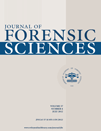Accuracy and Reliability of Cone Beam Computed Tomography of the Jaws for Comparative Forensic Identification: A Preliminary Study*
Presented in part to the Royal Society of Medicine, October 16, 2010, in London, U.K., and to the British Association for Forensic Odontology, November 13, 2010, in Stratford Upon Avon, U.K.
Abstract
Abstract: Conventional computed tomography is an emerging modality in forensic identification but is not sufficiently accurate for use in dental identification primarily because of problems with metallic dental restoration–induced streak artifact. In this study, the accuracy and reliability of recording forensic information from cone beam computed tomography (CBCT) scans of the jaws when compared to conventional panoramic radiographs has been analyzed under experimental conditions. Information could be recorded with near-perfect repeatability and reproducibility. Information could also be recorded accurately, the sensitivity being 96.6% (95% CI, 95.1–98.1) and specificity being 98.4% (95% CI, 96.2–100). The metal dental restoration–induced streak artifact was at a level that permitted, in most cases, accurate observations. This is considered an important step in validating CBCT as a tool in comparative dental identification of bodies. It may have a role in mass fatalities and in chemical, biological, radiological, and nuclear incidents, but further studies are required to assess the feasibility of this.




